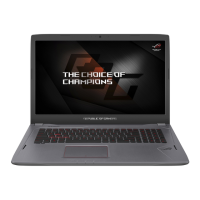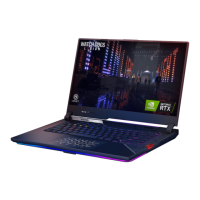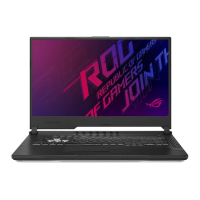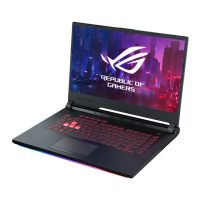Do you have a question about the Asus ROG Strix GL553VE and is the answer not in the manual?
Overview of the notebook's physical layout and components.
Initial setup and charging procedures for the notebook.
Detailed guide to touchpad gestures and functions.
Explanation of function keys, Windows keys, and multimedia keys.
Instructions for using the numeric keypad for input and navigation.
Steps for inserting and ejecting discs from the optical drive.
Guide to initial Windows 10 setup and configuration.
Navigating the Start menu and managing Windows applications.
Using Task view for multitasking and Snap feature for window management.
Accessing notifications and using keyboard shortcuts in Windows 10.
Connecting to wireless and wired networks.
Turning the notebook off and putting it into sleep mode.
Understanding POST and accessing the BIOS setup.
Configuring BIOS settings like boot order and security.
Steps to recover or reset the notebook's system.
Instructions for safely removing the notebook's access panel.
Guide to upgrading the notebook's memory capacity.
Steps for installing or replacing the notebook's hard disk drive.
Procedure for installing a compatible M.2 storage card.
Recommendations for maximizing notebook performance and data security.
Common questions and answers regarding notebook hardware.
Frequently asked questions about notebook software issues.
Details on DVD/Blu-ray drives and regulatory compliance statements.
Important safety, environmental, and regional notices.
Guidelines for safe operation and handling of the notebook.
Recommendations for cleaning and maintaining the notebook.
Instructions for environmentally responsible disposal of the notebook.
Overview of the notebook's physical layout and components.
Initial setup and charging procedures for the notebook.
Detailed guide to touchpad gestures and functions.
Explanation of function keys, Windows keys, and multimedia keys.
Instructions for using the numeric keypad for input and navigation.
Steps for inserting and ejecting discs from the optical drive.
Guide to initial Windows 10 setup and configuration.
Navigating the Start menu and managing Windows applications.
Using Task view for multitasking and Snap feature for window management.
Accessing notifications and using keyboard shortcuts in Windows 10.
Connecting to wireless and wired networks.
Turning the notebook off and putting it into sleep mode.
Understanding POST and accessing the BIOS setup.
Configuring BIOS settings like boot order and security.
Steps to recover or reset the notebook's system.
Instructions for safely removing the notebook's access panel.
Guide to upgrading the notebook's memory capacity.
Steps for installing or replacing the notebook's hard disk drive.
Procedure for installing a compatible M.2 storage card.
Recommendations for maximizing notebook performance and data security.
Common questions and answers regarding notebook hardware.
Frequently asked questions about notebook software issues.
Details on DVD/Blu-ray drives and regulatory compliance statements.
Important safety, environmental, and regional notices.
Guidelines for safe operation and handling of the notebook.
Recommendations for cleaning and maintaining the notebook.
Instructions for environmentally responsible disposal of the notebook.
| Bus type | DMI3 |
|---|---|
| Tjunction | 100 °C |
| Processor cache | 6 MB |
| Processor cores | 4 |
| Processor model | i7-7700HQ |
| System bus rate | 8 GT/s |
| Processor family | Intel® Core™ i7 |
| Processor series | Intel Core i7-7700 Mobile Series |
| Processor threads | 8 |
| Processor codename | Kaby Lake |
| Processor frequency | 2.8 GHz |
| Processor cache type | Smart Cache |
| Configurable TDP-down | 35 W |
| Processor lithography | 14 nm |
| Processor manufacturer | Intel |
| PCI Express slots version | 3.0 |
| Processor boost frequency | 3.8 GHz |
| Processor operating modes | 64-bit |
| ECC supported by processor | No |
| PCI Express configurations | 1x16, 1x8, 2x4, 2x8 |
| Thermal Design Power (TDP) | 45 W |
| Maximum number of PCI Express lanes | 16 |
| On-board graphics card | Yes |
| On-board graphics card ID | 0x591B |
| Discrete graphics card model | NVIDIA® GeForce® GTX 1050 Ti |
| On-board graphics card model | Intel® HD Graphics 630 |
| Discrete graphics card memory | 4 GB |
| Discrete graphics memory type | GDDR5 |
| Maximum on-board graphics card memory | 64 GB |
| On-board graphics card OpenGL version | 4.4 |
| On-board graphics card base frequency | 350 MHz |
| On-board graphics card DirectX version | 12.0 |
| On-board graphics card dynamic frequency (max) | 1100 MHz |
| Form factor | Clamshell |
| Product type | Laptop |
| Product color | Black |
| Market positioning | Gaming |
| Memory slots | 2x SO-DIMM |
| Internal memory | 16 GB |
| Memory form factor | SO-DIMM |
| Internal memory type | DDR4-SDRAM |
| Maximum internal memory | 32 GB |
| HDD capacity | 1000 GB |
| SSD capacity | 256 GB |
| Storage media | HDD+SSD |
| Optical drive type | DVD Super Multi |
| Total storage capacity | 1256 GB |
| Compatible memory cards | SD, MMC |
| Number of HDDs installed | 1 |
| Display diagonal | 15.6 \ |
| Native aspect ratio | 16:9 |
| Wi-Fi standards | 802.11a, Wi-Fi 5 (802.11ac), 802.11b, 802.11g, Wi-Fi 4 (802.11n) |
| Bluetooth version | 4.0 |
| Ethernet LAN data rates | 10, 100, 1000 Mbit/s |
| Charging port type | DC-in jack |
| USB 2.0 ports quantity | USB 2.0 ports have a data transmission speed of 480 Mbps, and are backwards compatible with USB 1.1 ports. You can connect all kinds of peripheral devices to them. |
| VGA (D-Sub) ports quantity | 0 |
| USB 3.2 Gen 1 (3.1 Gen 1) Type-A ports quantity | 2 |
| Pointing device | Touchpad |
| Battery capacity | 48 Wh |
| Battery technology | - |
| AC adapter power | 120 W |
| AC adapter frequency | 50 - 60 Hz |
| AC adapter output current | 6.3 A |
| AC adapter output voltage | 19 V |
| Motherboard chipset | Intel® HM175 |
| Processor ARK ID | 97185 |
| Processor package size | 42 x 28 mm |
| Supported instruction sets | AVX 2.0, SSE4.1, SSE4.2 |
| Intel Identity Protection Technology version | 1.00 |
| Intel Stable Image Platform Program (SIPP) version | 0.00 |
| Depth | 255 mm |
|---|---|
| Width | 383 mm |
| Height | 30 mm |
| Weight | 2500 g |











